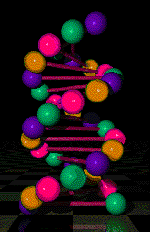|
 DNA
:WHAT IS IT? DNA
:WHAT IS IT?
DNA
(Deoxyribonucleic acid) is a chemical structure that forms chromosomes. A piece of a
chromosome that dictates a particular trait is called a gene.
Structurally, DNA is a double helix: two strands of genetic
material spiraled around each other. Each strand contains a sequence
of bases (also called nucleotides). A base is one of four chemicals
(adenine, guanine, cytosine and thymine). The two strands of DNA are connected at each base. Each base will
only bond with one other base, as follows: Adenine (A) will only
bond with thymine (T), and guanine (G) will only bond with cytosine
(C). Suppose one strand of DNA looks like this:
A-A-C-T-G-A-T-A-G-G-T-C-T-A-G
The DNA strand bound to it will look like this:
T-T-G-A-C-T-A-T-C-C-A-G-A-T-C
Together, the section of DNA would be represented like this:
T-T-G-A-C-T-A-T-C-C-A-G-A-T-C
A-A-C-T-G-A-T-A-G-G-T-C-T-A-G
DNA strands are read in a particular direction, from the top
(called the 5' or "five prime" end) to the bottom (called
the 3' or "three prime" end). In a double helix, the
strands go opposite ways:
5' T-T-G-A-C-T-A-T-C-C-A-G-A-T-C 3'
3' A-A-C-T-G-A-T-A-G-G-T-C-T-A-G 5'
|
|
|
The application of DNA technology in forensic science has generated considerable excitement, both in the criminal justice community and in the popular media. |
|
DNA FINGERPRINTING
The chemical structure of everyone's DNA is
the same. The only difference between people (or any animal)
is the order of the base pairs. There are so many millions of
base pairs in each person's DNA that every person has a
different sequence.
Using these sequences, every person could
be identified solely by the sequence of their base pairs.
However, because there are so many millions of base pairs, the
task would be very time-consuming. Instead, scientists are
able to use a shorter method, because of repeating patterns in
DNA.
These patterns do not, however, give an
individual "fingerprint," but they are able to
determine whether two DNA samples are from the same person,
related people, or non-related people. Scientists use a small
number of sequences of DNA that are known to vary among
individuals a great deal, and analyze those to get a certain
probability of a match.
|
|
|